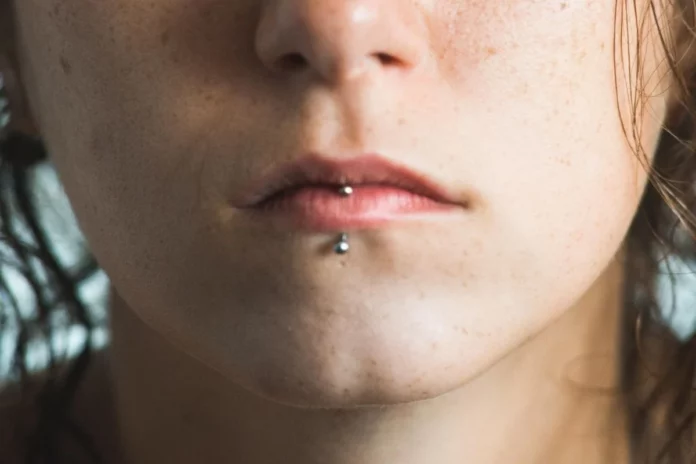Ashley piercing scar can make your facial feature look bad so before you get an Ashley piercing, make sure it’s safe and won’t leave a scar. Ashley piercings are a bold and beautiful way to express yourself.
An Ashley piercing, also called a lip piercing, goes through your bottom lip and comes out through the top. Like any piercing, it might leave a scar, so be careful.
Piercings can add a daring touch and make you look more beautiful. Both men and women can get an Ashley piercing.
Remember, the Ashley piercing procedure can be tough for some people. Know about scarring risks before deciding.
If you’re worried about scars, this Ashley Piercing Scar guide will help you. Enjoy the stunning look of Ashley piercings, expressing yourself with courage and style.
Can Ashley Piercing Cause Scarring? Understanding Ashley Piercing Scar Risks
An Ashley piercing can be uncomfortable because it goes through a large part of the lip, which may cause scarring when removed. Women can easily hide the dark scar, but it might be harder for men.
To avoid scarring, follow some guidelines: don’t bite your lips after getting the piercing, and avoid playing with the stud on your lip, as it can hurt the tissue and cause scarring. By being careful, you can prevent an Ashley lip piercing scar.
Sometimes, scars can appear for no reason. You can use lipstick to hide the Ashley piercing scar in such cases. Remember, all lip piercings, including Ashley piercings, can cause scarring, so take good care during healing and prevent infections.
The severity of the scar can vary depending on your skin type and how well you heal. If you’re worried about scarring, talk to your piercer before getting the Ashley piercing and follow their aftercare instructions closely.
If you notice signs of infection or scarring, seek help from a healthcare professional or dermatologist promptly. Scarring is possible with an Ashley piercing, but it might look different – often as small bumps around the piercing site.
Minimizing Ashley Piercing Scar: Understanding the Potential Lip Scarring
Having a scar from an Ashley piercing is quite rare. This is because the lip tissue is different from ear tissue or cartilage, so any scarring is usually minor, showing up as a small bump near the piercing site, like a piercing bump or a persistent keloid.
If you decide to remove the piercing, the hole can close up at different speeds. Fresh piercings, less than six months old, may close within a few hours, while older ones might take a couple of months.
Generally, the scarring isn’t very noticeable unless a keloid forms. The healing time for an Ashley piercing varies, typically taking around 3 to 4 months, depending on how quickly your body heals.
To be sure about your piercing’s healing progress, it’s best to check with your piercer and not stop the aftercare until they give the go-ahead. Even after complete healing, some visible scar tissue may still be at the piercing site, usually slightly raised or discolored.
While it’s challenging to completely get rid of a healed Ashley piercing scar, different treatment options are available to minimize its appearance. These include using silicone scar sheets, scar creams and ointments, and exploring laser therapy with the guidance of a professional.
Can You Hide an Ashley Piercing Scar?
Hiding the scar from the Ashley piercing is easy if the scarring is minimal or you only want to conceal the piercing site. Apply some lipstick or lip gloss, preferably in a darker color than your natural lip color, and it will do the trick.
However, hiding bumps and keloids might be a bit more challenging. Depending on their size, you could try using a thicker application of lipstick or gloss.
Ashley Piercing Scar: The Causes of Ashley Piercing Lip Scar
The Ashley piercing procedure can be uncomfortable as it goes through a large area of tissue on the lip, which may result in a dark scar after removal. Women can often hide this scar more easily than men.
To avoid scarring, follow these guidelines: avoid biting your lips after getting the piercing and don’t play with the lip stud, as it can hurt the tissue and cause scarring. Following these steps can reduce the chances of getting an Ashley piercing scar.
Sometimes, a scar may appear without any clear reason. In such cases, you can try using lipstick or lip gloss to cover the Ashley lip piercing scar.
Scarring with an Ashley piercing is often caused by moving the jewellery while the piercing is healing. Also, wearing heavier jewelry during the healing process can lead to scarring as it stresses the piercing, making proper healing difficult.
Ignoring any irritation or scarring at the Ashley piercing site may lead to the formation of a keloid, which is an excess of scar tissue. Keloids can be big and raised, though they are not usually painful.
Keloid scars are challenging to eliminate. You may need to seek help from a dermatologist and undergo various treatments, and even then, it may take several months for the keloid scar to fade away completely.
What Can You Do to Prevent Ashley Piercing Scars?
To avoid problems with an Ashley piercing, follow these tips:
- Choose an experienced piercer who knows what they are doing.
- Before getting the piercing, discuss the type of jewellery with your piercer. Start with simple, light jewellery like sterling silver, gold, or platinum.
- Take proper care of your piercing after getting it. Rinse your mouth after eating and follow your piercer’s instructions.
- If you’re not confident in changing the jewellery yourself, let your piercer do it for you.
- To reduce scarring, use safe materials for your jewellery, avoid harsh chemicals, and prevent injury to the piercing site.
- Keep an eye on the piercing for any signs of infection or scarring, and seek medical help if needed.
By following these tips, you can enjoy your piercing with fewer risks of Ashley Piercing Scar.
Signs Of An Ashley Piercing Scar
Get treatment promptly if you see any issues like scarring, bumps, or other problems around your Ashley piercing. Your piercer may advise you if it’s early. To avoid permanent scarring, visit a doctor or dermatologist for better treatment.
An Ashley piercing scar can look different, like raised, colored, or firm tissue. It might itch or hurt when touched. Some scars can leave a depression around the piercing.
Some scarring during healing is normal, but watch for signs of infection or excessive scarring. If you notice any, see a healthcare provider or dermatologist right away. They can help you heal properly and avoid problems.
How To Get Rid Of An Ashley Piercing Scar?
Treating an Ashley piercing scar can be challenging, but there are options to help make it less visible:
- Silicone scar sheets: These sheets gently press on the scar, flattening and softening it. Wearing them daily can show results over time.
- Scar creams and ointments: Products with vitamin E, aloe vera, and onion extract moisturize the skin and improve its texture, reducing the scar’s appearance.
- Laser therapy: This treatment uses light to target the scar tissue, helping it heal and become less noticeable. It may take several sessions, and there might be some discomfort.
- Surgery: In severe cases, surgery can remove the scar tissue. It’s done with local anesthesia, and the wound is properly closed.
Remember to consult a dermatologist or healthcare professional before trying any treatment. They can guide you based on your skin type and condition, as not all treatments work for everyone.
How I Do Know If My Ashley Piercing Is Rejecting?
When you get a Ashley lip piercing or any other piercing, there’s a chance your body may not accept it, and this is called rejection. Look out for signs of rejection in your Ashley piercing.
One sign is if more of the stud shows on the outside of your lip. Also, if the piercing stays sore or irritated even after a few days, it might be a problem. Another warning sign is if the piercing hole gets bigger.
If you notice these signs, see your piercer. They can check your piercing and help you with the issue. If it’s not rejection, they will take care of it properly. Keep an eye on your piercing and take care of it well.
How Much Does The Ashley Piercing Hurt?
When you get an Ashley piercing on your lip, you might be worried about how much it will hurt. But most people say the pain is moderate and varies from person to person.
A skilled piercer can help you feel more comfortable by guiding you through some breathing exercises to relax and distract you during the piercing. So, finding a reliable piercer before getting your Ashley lip piercing is essential.
After the piercing, it’s normal to have some swelling and throbbing, but don’t worry, it’s part of the healing process. The swelling usually goes away after a few days, so be patient and let your body heal.
Ashley Piercing teeth damage
When you have a new piercing, be cautious not to bite on the jewelry as it can lead to issues. Also, keep an eye on any potential damage to your teeth caused by the jewelry rubbing against them while talking or chewing. Switching to a smaller stud may reduce pressure on your teeth, but some contact may still occur. Stay mindful of these factors to ensure proper care for your piercing and teeth.
More Body Piercings
Double Nose Piercing: A Complete Guide
Nose Piercing 101: Everything You Need to Know
Getting Your Ears Pierced at Target (Through Rowan)
Ashley Piercing: Everything You Need to Know About Eye-Catching Lip Piercing
Conclusion
An Ashley piercing can be a beautiful way to express yourself but may cause scarring. Choose an experienced piercer to minimise scars, follow aftercare instructions, and use safe materials.
If you notice signs of infection or excessive scarring, seek medical help. Treatment options like silicone scar sheets and creams can reduce scar appearance. Prioritize your health and well-being when getting a piercing and enjoy expressing yourself responsibly.
FAQs: Ashley Piercing Scar
Q: Will getting an Ashley piercing cause scarring?
A: There is a possibility of scarring when getting an Ashley piercing. It goes through a significant part of the lip, which may lead to scarring when removed. To minimize scarring, follow aftercare instructions, avoid biting the lips, and prevent infections.
Q: Is lip scarring significant with Ashley piercings?
A: Generally, scarring from Ashley piercings is minor and may appear as small bumps near the piercing site. The healing time varies, and the scar may not be very noticeable unless a keloid forms.
Q: Can you hide an Ashley piercing scar?
A: You can conceal minimal Ashley piercing scar by using lipstick or lip gloss. However, hiding larger bumps or keloids may be more challenging.
Q: Why does an Ashley piercing leave behind a scar?
A: The piercing procedure goes through a significant area of lip tissue, which may result in scarring when removed. Avoiding lip biting and not playing with the lip stud can help reduce the chances of scarring.
Q: How can I prevent scarring with an Ashley piercing?
A: Choose an experienced piercer, use safe jewelry materials, and properly care for the piercing. Avoid harsh chemicals and prevent injury to the piercing site. Monitor for signs of infection or scarring and seek medical help if needed.
Q: What are the signs of an Ashley piercing scar?
A: An F can appear raised, colored, or firm, and it may itch or be tender when touched. Some scars can leave a depression around the piercing.
Q: How can I treat an Ashley piercing scar?
A: Treating the scar can be challenging, but options include silicone scar sheets, scar creams, ointments, and laser therapy. In severe cases, surgery may be necessary. Consult a dermatologist or healthcare professional before trying any treatment.
Q: How do I know if my Ashley piercing is rejecting?
A: Signs of rejection include more of the stud on the outside of the lip, persistent soreness or irritation, and enlarging the piercing hole. If you notice these signs, consult your piercer promptly.
Q: Does an Ashley piercing hurt?
A: The pain experienced during an Ashley piercing is usually moderate and varies from person to person. A skilled piercer can guide you through breathing exercises to help you relax.
Q: How long does it take for an Ashley piercing to heal?
A: The healing time for an Ashley piercing is typically around 3 to 4 months, depending on individual healing rates. Follow your piercer’s aftercare instructions for proper healing.




